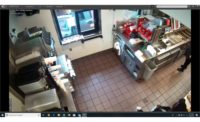Convenience stores and mini marts have traditionally installed surveillance cameras to deter crime and encourage safety, but too often these have provided images that lacked detail, particularly in low light conditions. Retrieving video has usually been tedious, requiring endless searching and scanning to find the desired footage. Sharing and archiving of the video has also been cumbersome, wasting precious technical and management resources.
Now advanced digital IP video cameras and recorders are capturing clearer images inside and outside the store in various lighting conditions to deter theft, fraud, and unjustified claims such as slip and fall incidents. By providing easily retrievable and emailable surveillance video evidence, this approach is even enabling the swift collection of full compensation when store property is damaged. The surprisingly economical IP network surveillance systems are also enabling executives to efficiently monitor
store conditions from home, headquarters, or anywhere with an internet connection.
“With an advanced surveillance camera system, a convenience store chain could achieve ROI within a year through better prevention of theft, fraud, and unjustified claims as well as improved operational oversight,” said Todd Harrison, IT director who oversees loss prevention camera surveillance for Sprint Food Stores, which operates 20 convenience stores in Georgia and
South Carolina.
Previously, Sprint Food Stores used lower resolution cameras that required onsite DVD burning as a means of storage. According to Harrison, limitations in surveillance video quality and connectivity were the main reasons that the convenience store chain sought an alternative.
As a solution, Harrison turned to an advanced surveillance camera system provided by ERC, a supplier and integrator of surveillance and POS systems. The company has provided over 10,000 stores and restaurants with surveillance
or POS systems including Arby’s, Popeyes, KFC and Burger King.
The integrator supplied Sprint Food Stores with a complete surveillance video system, including various high-resolution digital cameras, network video recorders, and related equipment. This provides comprehensive video coverage inside and outside of stores, the corporate office, and remote offices, even in low-light/varying light conditions, and enables adjusting the angle or
focus to capture the visual evidence required.
“ERC worked with us on exact camera placement and suggested slight adjustments to improve visibility and get the maximum coverage with the minimum number of cameras,” Harrison said.
One benefit of implementing the new surveillance system was how it eliminated “blind spots” within stores, such as inside a walk-in beer cooler, which made it easy to prevent theft and catch thieves, he added.
“We put a camera inside the walk-in beer cooler and at other blind spots so we can monitor them at the front counter,” he said. “This prevents theft so we don’t have to prosecute, and provides video evidence if we do.”
Among the equipment installed in stores, Harrison appreciates a 3-megapixel fisheye network camera that provides a full, 360-degree view over a web browser. This provides three, simultaneous pan, tilt and zoom video streams that can be viewed live or recorded.
“The great part about the 360-degree view camera is being able to view the whole store,” Harrison said. “You can zoom in for a close up of what you want to focus on, and quickly see which store camera has the best view.”
Deterring and disproving fraudulent claims is another benefit of implementing easily accessible, high quality surveillance video. The information can be used to deter unwarranted claims for slip and fall or workers compensation, for example.
“When a store was involved with a slip and fall claim, we were able to show on video that other customers took the same path as the accuser without incident, and that less harm was involved than stated,” Harrison said. “We retrieved the video, sent it to her lawyer, and her lawyer dropped the case.”
Surveillance video can even be used as evidence to collect costly damage to equipment or store property. Harrison relates how at one location a truck driver ran into a 3-ft. high, LED diesel fuel sign, destroying it, before driving off.
“When we emailed the trucking company high-quality surveillance video of the incident with their truck/trailer number and company name clearly readable, we were promptly compensated,” Harrison said. “That alone paid for the store’s surveillance system.”






